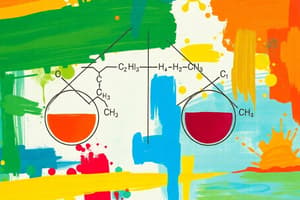Podcast
Questions and Answers
What does the law of conservation of mass state?
What does the law of conservation of mass state?
The mass of the starting substances (reactants) must be equal to the mass of the finishing substances (products).
When water evaporates on a hot day, does the mass of the water change?
When water evaporates on a hot day, does the mass of the water change?
No, the mass of the water is not lost; it has changed into a gas.
What does the coefficient in a chemical equation represent?
What does the coefficient in a chemical equation represent?
The coefficient tells us how many molecules of that substance are involved in the reaction.
Why is it important to balance chemical equations?
Why is it important to balance chemical equations?
What does it mean when a chemical equation is balanced?
What does it mean when a chemical equation is balanced?
How many oxygen atoms are there in 3 H2O molecules?
How many oxygen atoms are there in 3 H2O molecules?
How many sulfur atoms are in 2 H2SO4 molecules?
How many sulfur atoms are in 2 H2SO4 molecules?
How many hydrogen atoms are there in 5 CO2 molecules?
How many hydrogen atoms are there in 5 CO2 molecules?
How many chlorine atoms are in 3 HCl molecules?
How many chlorine atoms are in 3 HCl molecules?
How many copper atoms are in 6 CuCO3 molecules?
How many copper atoms are in 6 CuCO3 molecules?
Study Notes
Chemical Equations
- A chemical equation is a way of writing down what happens in a chemical reaction, similar to a cooking recipe.
- Chemical equations show which reactants produce which products, and include the required reaction conditions for that reaction.
- Reactants are always on the left, and products are always on the right.
- An arrow is drawn from the reactants to the products.
- Plus signs are used to connect multiple reactants or products.
- Reaction conditions are written above the arrow.
Conservation of Mass
- The Law of Conservation of Mass states that mass is never lost or gained during a chemical reaction.
- Mass stays the same - it is conserved.
- In a chemical reaction, the mass of the starting substances (reactants) must be equal to the mass of the finishing substances (products).
- This means we have the same number of atoms, and the same type of atoms, arranged differently.
Balancing Chemical Equations
- Balancing a chemical equation means ensuring the same number and type of atoms are present in the reactants and products.
- Only the big numbers (coefficients) are changed, not the small numbers (subscripts).
- States of reactants and products must be included.
- Tables can be used to balance more difficult equations.
- Lowest common multiples are used to balance equations.
Rates of Reaction
- Three things that can speed up the rate of reaction are:
- Temperatures
- Surface area
- Concentration
Studying That Suits You
Use AI to generate personalized quizzes and flashcards to suit your learning preferences.
Description
Test your knowledge on balancing chemical equations with this quiz. Practice balancing different reactions by ensuring the number of atoms of each element is the same on both sides of the equation.




